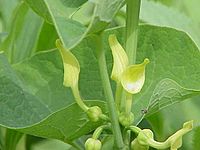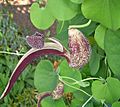Aristolochia facts for kids
Quick facts for kids Aristolochia |
|
|---|---|
 |
|
| Aristolochia clematitis | |
| Scientific classification | |
| Kingdom: | |
| Division: | |
| (unranked): | |
| Order: | |
| Family: | |
| Subfamily: | |
| Genus: |
Aristolochia
|
| Species | |
|
Over 500, see text |
|
Aristolochia is a large plant genus with over 500 species of shrubs and herbs, many having medicinal properties. Collectively known as birthworts, pipevines or Dutchman's pipes, they are the namesake of the family (Aristolochiaceae). They are widespread and occur in the most diverse climates. Some species, like A. utriformis and A. westlandii, are threatened with extinction.
Isotrema is usually included here, but might be a valid genus. If so, it contains those species with a three-lobed calyx.
Description

Aristolochia is a genus of evergreen and deciduous lianas (woody vines) and herbaceous perennials. The smooth stem is erect or somewhat twining. The simple leaves are alternate and cordate, membranous, growing on leaf stalks. There are no stipules.
The flowers grow in the leaf axils. They are inflated and globose at the base, continuing as a long perianth tube, ending in a tongue-shaped, brightly colored lobe. There is no corolla. The calyx is one to three whorled, and three to six toothed. The sepals are united (gamosepalous). There are six to 40 stamens in one whorl. They are united with the style, forming a gynostemium. The ovary is inferior and is four to six locular.
These flowers have a specialized pollination mechanism. The plants are aromatic and their strong scent attracts insects. The inner part of the perianth tube is covered with hairs, acting as a fly-trap. These hairs then wither to release the fly, covered with pollen.
The fruit is dehiscent capsule with many endospermic seeds.
Images for kids
-
Aristolochic acid, the main toxin of pipevines
See also
 In Spanish: Aristolochia para niños
In Spanish: Aristolochia para niños













